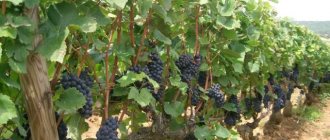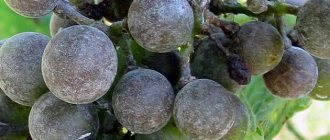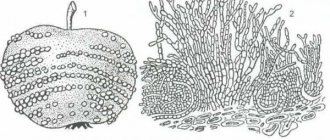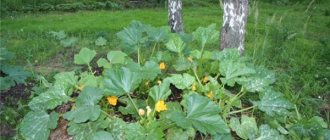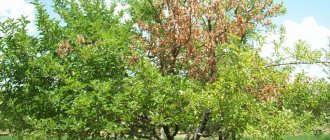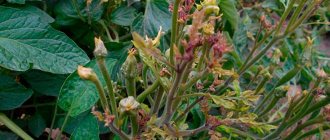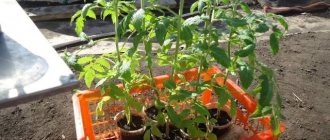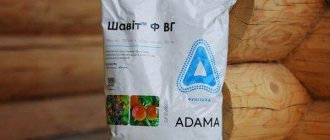Throughout the season, gardeners carefully care for the grapes in hopes of a rich harvest. It is all the more painful to see how already ripened bunches disappear one after another, becoming covered with a gray fluffy coating. This is one of the most common diseases not only of grapes, but also of other fruit crops - gray rot. The article discusses the main symptoms of the disease and provides recommendations for treatment.
What is gray mold: general information
The causative agent of the disease is the fungus Botrytis cinerea. Hence another name for the disease - botrytis. Gray mold can develop even at low positive temperatures of 3-4 °C; the optimal temperature is 20-30 °C. As with other fungal diseases, in order for infection to begin, it requires dripping moisture in which to germinate spores. The latent (incubation) period from the moment the pathogen enters the plant until symptoms appear is about 4 days. The fungus overwinters on wood, in last year's litter, on infected berries and leaves that remain on the bush.
Localization and signs of bush disease
Rot spreads to different parts of the plant. It affects not only fruits, but also inflorescences, shoots, leaves, and brushes. At each site certain signs are visible.
Inflorescences
Fruit formation begins on the inflorescences. The berries begin to deteriorate even before they ripen. Even at the initial stage of their formation, fruits dry out, die and fall off. With such a defeat, it is possible to lose more than 50% of the crop.
See also
Description and characteristics of the Pamyati Negrul grape variety, planting and care
Read
Brushes
If flowering and fruit set are successful, the berries are tied into clusters. Each of them consists of more than 30 berries. If an infection occurs at this moment, the fruits stop growing and developing. They freeze at a point, gradually change color, the brushes dry out, release juice, and become covered with a white or gray fluffy coating.
Branches
On the branches of the vineyard, the manifestation of symptoms is quite characteristic, as for other parts of the plant. The vine becomes brown and covered with a gray coating. The surface becomes dry, yellow, and in some cases discolored. After the branches are damaged, the fungus spreads to the fruits.
Leaves
Green leaves of grapes are affected by the fungus at the beginning of penetration. Brown spots appear on them. They gradually increase in size, then become covered with a particularly characteristic coating. They become gray with edges. Next, the fungi suck out all the juices from the leaves, they dry out and curl.
Symptoms of the disease
In rainy spring, a gray spore-bearing coating of the fungus can cover the tops of shoots, budding buds, leaves, and the ridges of bunches. During flowering, the inflorescences turn brown and fall off. Affected tissues rot and eventually die. For example, the photo shows gray rot of grapes on the leaves: the disease manifests itself in the form of brown spots, both with and without traces of sporulation.
Damage to berries is usually associated with a violation of the integrity of the outer shell (peel). On berries that are just beginning to ripen, rot appears after they have suffered from an attack by pests (for example, leaf rollers), rain or hail. The first symptoms are small watery spots. The berries then change color to dark blue. The next stage in the development of the disease is the appearance of a solid gray (sometimes yellow) coating and drying of the berries in the bunch.
Already ripe berries crack after heavy rains. Then the first traces of fungus are found around the cracks. Further, the grapes become flabby, the skin is easily separated. The taste and smell are hopelessly spoiled. The disease can appear on grapes after harvest, during transportation and storage.
Important!!! To distinguish gray rot from similar fungal diseases, the affected berry or cutting is placed in a humid environment in the refrigerator for several hours. Unlike other pathogens, the fungus Botrytis cinerea continues to develop at low temperatures, forming a fluffy coating on the test sample.
Types of rot
Grape bushes are susceptible to various types of rot. They are divided into gray, white, black, sour, aspergillus.
Gray
The disease is caused by a fungus. It is stored in winter under the bark or under the roots of the vineyard. In spring, fungal spores spread and land on healthy shrubs. After which the fruits are damaged, they begin to deteriorate.
The fungus looks like a gray fluffy coating on the berries; after withering, the grapes crumble. It cannot be used for food, processed, or made into wine. The disease quickly spreads throughout all areas of the bush.
White
A fungus also causes the disease. It lives in the soil, in the spring it moves onto shoots and infects grape bunches. In dry weather, light spots appear on the berries; in wet weather, black spots appear. These are the first signs of rot. Then the grapes crack and begin to rot.
White rot is not capable of affecting the entire bush, so taking urgent measures will help cope with the problem.
Black
The most dangerous type of fungus. It affects berries, and in a more advanced stage it spreads to leaves, shoots, cuttings and other parts of the bush. The spores persist in the soil in winter and migrate to the body of the bush in the spring.
Infection occurs in both overripe and young berries. They turn black, wrinkle, burst, and release juice. The fungus spreads quickly. Capable of destroying more than 80% of the crop.
Aspergillus
The disease is caused by more than 10 fungi of the same genus. The disease is common in hot southern regions. The fungus begins to multiply in high humidity and hot temperatures. It gets onto the shoots of the vineyard and is spread by parts of the fungus’ body.
The berries turn brown, become soft, and deflate. They begin to leak juice, wrinkle, and dry out.
Sour (acetic)
The fungus penetrates the surface of the fruit with the help of wind. They are stored in the winter in the roots of the plant. After infection penetrates, uncharacteristic spots appear on the berries. The fruits shrink and lose juice. The grapes begin to ferment from the inside. Grape juice produces acetic acid during fermentation. That's why this type of rot got its name.
The problematic nature of the struggle
The insidiousness of gray rot is that it causes the greatest damage to almost ripe berries, when it is too late to take action: harvesting soon and using chemicals is simply dangerous to health. Each drug has its own waiting period, which must be met before picking berries.
Another difficulty arising from the first is that the time of chemical treatment should be calculated separately for each group of grape varieties, depending on their ripening period. We subtract the required waiting period for the drug from the expected harvest date and spray. We will consider specific schemes and means below.
Reasons for appearance
The causes of rot infection are different. Why do grapes rot? This is largely influenced by weather conditions. Long rains favor the appearance of gray and black rot. White occurs after long dry days.
Gray rot affects the entire plant. But it is especially dangerous for ripe berries. If there is excess moisture, the skin bursts, and the fungus quickly multiplies in favorable conditions. The same result occurs after hail falls, which injures the delicate skin of the berries. Damage is caused by wasps and garden pests.
When berries are infected with black rot, part of the crop dies. Shoots and leaves are not in such danger.
In the spring, the white rot fungus awakens, having overwintered in the bark and fallen leaves, and attacks the shoots. Sunburn is another reason for the rapid spread of the disease. If affected berries are not harvested in time, healthy fruits become infected.
Control and prevention measures
How to deal with gray rot on grapes. The solution consists of a combination of agricultural techniques using protective drugs:
- leaves around the bunches are removed for better ventilation;
- to ensure access to sunny color, the crown is not thickened;
- ripe bunches are removed in time so as not to provoke their rotting;
- all affected berries are immediately removed;
- When carrying out preventive treatments, they are guided by the phases of grape development.
Before you start treating with chemicals, you should determine the phases of plant development when the likelihood of infection increases. For varieties of early and medium ripening, these are the following stages:
- bloom;
- closing berries in a bunch;
- start of coloring.
For late-ripening varieties, you need to pay attention to the beginning of berry ripening and the period before harvest.
It is during these phases, especially during the rainy season, that grapes are treated against gray rot. For example, according to this scheme:
| Development phase | A drug |
| extension of inflorescences | Horus |
| bloom | Horus, Skor |
| berry ripening | Switch |
Important!!! Since gray rot often begins inside the bunch, treating the bush with a fungicide at the stage of closure of the berries in the bunch should be a mandatory element of the protection scheme. At the same time, the maximum number of treatments with modern drugs should not exceed 4, in dry summers - 2.
How and with what to treat grapes against gray rot: preparations for spraying
So, you have figured out when to process grapes, now you just need to understand how to most effectively carry out the spraying themselves and what fungicidal preparations (anti-disease agents) can be used.
How to spray correctly
- Treatments should be carried out in a preventive mode , trying to prevent the appearance and development of the disease.
At the same time the treatment will be more effective if you carry it out before the rain, and not after . In other words, you need to carefully monitor the weather forecast .
- Contact preparations are washed off by rain , which means that if it rains after treatment, it must be repeated every other day.
But systemic drugs get inside the plant within 3-4 hours and are not washed off by rain , which means that regardless of the weather, treatment is carried out according to regulations.
- If you find the first signs of disease on the bush, then you need to use fungicides with a therapeutic effect (or protective-therapeutic) .
- Treatment preparations should be changed periodically , i.e. use alternately (do not use more than twice in a row) so that there is no resistance (the fungus cannot adapt to the active ingredient of the drug).
In this case, it is not the name of the drug that should change , but the active substance .
- In case of severe infection, treatment should be with a tank mixture of 2 drugs (with different active ingredients).
- Before use, carefully read the instructions for the drug , be sure to familiarize yourself with the dosage, frequency of use and waiting period (how many days after treatment can the fruits be eaten).
The fact is that the most active development of gray rot occurs at the end of grape ripening, and the waiting period for some chemical preparations is quite long (30 days or more), in other words, they cannot be used. But for biological agents waiting period at all or it may be minimal (1-3 days).
Chemical fungicides
Chemical preparations for the protection (prevention) and treatment of gray rot of grapes (the active substances are indicated in brackets, as well as the method of penetration and the nature of the effect):
Many preparations for gray rot of grapes are sold only in large containers (for professional farmers); for summer residents (personal plots) in small packages you can find Skor, Chorus, Medea, Tilt (Forecast, Agromedicine), Profit Gold, Teldor and Switch (only in Ukraine) , Acrobat MC, Bayleton, Fundazol and Topsin-M.
- Coside 2000 ( copper hydroxide , protective contact fungicide).
- Bravo ( Chlorothalonil , a protective contact fungicide);
- Poliram DF ( Metiram (Polycarbocin) , contact fungicide with protective action);
- Buzzer ( Fluazinam , a protective contact fungicide);
- Merpan ( Kaptan , a protective contact fungicide);
Analogue - Tuning fork.
- Rovral ( Iprodione (Rovral) , contact fungicide with protective and curative action);
- Tercel ( Dithianon and Pyraclostrobin , contact fungicide with protective and curative action);
- Luna Experience ( Pyrimethanil and Fluopyram , a systemic curative fungicide);
- Luna Tranquility ( Pyrimethanil and Fluopyram, a systemic fungicide with curative action);
- Universal ( Tebuconazole , systemic fungicide with protective and curative action);
- Folicur ( Tebuconazole , systemic fungicide with protective and curative action);
Analogues - Kolosal, Ikarus, Tebuzol.
- Collis ( Boskalid and Kresoxim-methyl , systemic fungicide with protective and curative action);
- Canthus ( Boscalid, a systemic fungicide with protective action);
- Bellis ( Boscalid and Pyraclostrobin, systemic contact fungicide of protective action);
- Signum ( Boskalid and Pyraclostrobin, systemic contact fungicide of protective action);
- Teldor ( Fenhexamide , a local-systemic protective fungicide);
- Topaz ( Penconazole (Topaz) , a systemic fungicide with protective action);
Note! The product is rather weakly effective. Suitable only for prevention if the weather is not very favorable for the development of fungus (rare rains).
- Switch ( Fludioxonil and Cyprodinil , contact-systemic fungicide with protective and curative action);
- Tilt ( Propiconazole
, a systemic fungicide with protective and curative effects);
Analogues - Agromedicine, Forecast, Chistoflor.
- Title 390 ( Propiconazole,
systemic fungicide with protective and curative action); - Acrobat MC ( Dimethomorph and Mancozeb , systemic contact fungicide with protective action);
- Skor ( Difenoconazole , systemic contact fungicide with protective and curative action);
Analogues - Rayok, Guardian, Pure Flower.
- Horus ( Cyprodinil , a systemic fungicide with protective and curative action);
- Bayleton ( Triadimefon (Bayleton), systemic fungicide with protective and curative action);
Analogues - Bayzafon , Privent .
- Medea ( Difenoconazole and Flutriafol , systemic contact fungicide with protective and curative action);
- Profit Gold ( Famoxadone and Cymoxanil , systemic contact fungicide with protective and curative action);
Analogues - Thanos, Ulysses.
- Fundazol ( Benomyl (Fundazol) , systemic contact fungicide of protective action);
- Topsin-M ( Thiophanate-methyl
, systemic contact fungicide with protective action);
Analogues - Thiophene, Thioma.
- Rex Duo ( Thiophanate-methyl and Epoxiconazole , systemic contact fungicide with protective and curative action).
Biological products
If you are against the use of chemicals, then you can fight gray mold on grapes using regular spraying with biological preparations (the active substances are indicated in brackets, as well as the method of penetration and the nature of the effect):
Biological products with fungicidal action :
- Alirin-B ( Bacillus subtilis strain B-10 VIZR, systemic contact fungicide with protective and curative action);
- Gamair ( Bacillus subtilis strain M-22 VIZR , systemic contact fungicide with protective and curative action).
- Fitosporin ( Bacillus subtilis strain 26 D , systemic fungicide with protective and curative effects);
- Baksis (Bacillus subtilis strain 63-Z, protective and curative fungicide);
- Sporobacterin ( Bacillus subtilis and Trichoderma viride, strain 4097 , systemic contact fungicide with protective and therapeutic action);
- Planriz ( Pseudomonas fluorescens strain AP-33, contact fungicide);
- Rizoplan ( Pseudomonas fluorescens strain AP-33 , contact fungicide);
Planriz and Rizoplan are complete analogues.
- Trichoderma veride , strain 471 , protective fungicide;
- Trichoplant ( Trichoderma lignorum , protective fungicide);
- Trichocin ( Trichoderma harzianum , protective fungicide);
Trichodermin, Trichoplant, Trichocin and Trichoderma Veride are all based on fungi of the Trichoderma genus.
- Glyocladin ( Trichoderma harzianum strain 18 VIZR , systemic contact fungicide with protective and curative action;
- Gaupsin (two strains of soil bacteria Pseudomonas aureofaciens, insectofungicide with complex action).
Use of chemicals and biologicals
Manufacturers offer a lot of highly effective pesticides against fungal diseases of grapes. Let's look at some common drugs:
| A drug | View | Usage rate per 100 m2 per 10 liters of water | Number of treatments (max) | Waiting period, days |
| Teldor | chem. | 10 g | 1-3 | 4 |
| Alirin-B | bio. | 10 tab. | 3 | — |
| Gamair | bio. | 10 tab. for 15-20 l | 2 | — |
| Horus | chem. | 6-7 years | 3 | 7 |
| Switch | chem. | 8-10 g. | 3 | 14 |
| Score | chem. | 3-4 years | 4 | 10 |
Important!!! When carrying out treatments, not only the bunches are sprayed, but also the leaves throughout the bush until they are abundantly wetted. But you shouldn’t be too zealous: drops of the drug should not flow to the ground.
White rot of grapes
Caused by the fungus Coniothyrium diplodiella Sacc. Plants are affected in hot weather, often at the end of berry ripening. The berries turn brown, dry out, take on a boiled appearance, the color is purple, concentric. The leaves dry out, become dirty green, and do not fall off. On the shoots there are gray-white elongated spots, often ringing the shoots. Tubercles of pycnidia are noticeable everywhere; in the end, the color of the affected berries becomes dirty white. The ripening pycnidia lift the skin of the berries, allowing air to penetrate between it and the pulp. Therefore, the berries appear white, the skin is easily removed with a bag. Outbreaks of the disease are observed after hail, on berries damaged by burns, and in thickened bushes. The need to treat separately from white rot is rare. Unless immediately after a hail, using copper-containing preparations or others.
Treatments of vineyards against mildew or oidium also affect the causative agent of white rot of grapes.
Traditional methods of fighting
When ripe berries are affected by gray rot, it is too late to spray with preparations. To save the harvest, gardeners will find folk recipes useful. Amateur winegrowers advise treating berries with pharmaceutical iodine (a solution of 30-40 drops per 10 liters of water). It destroys fungus on the surface and prevents infection from spreading. Ordinary baking soda (3-5% concentration) and a pink solution of potassium permanganate have the same property. These two products can be used simultaneously. As a preventive measure, during the closing phase of the bunches, the berries are treated with a 3% solution of laundry soap. After rains, the treatment is repeated.
Important!!! These drugs work only superficially and do not have a long-term effect. As soon as they evaporate, the grapes become vulnerable again.
How does mildew appear on grapes?
A characteristic sign of the disease is the appearance of yellow oily spots on the upper side of the leaf (primarily on young and tender leaves). Then, in humid and warm weather, a white fluffy coating forms under the spots on the underside of the leaves. If urgent control measures are not taken, mildew develops so strongly that by the end of summer bare, blackened shoots remain on the bushes.
In the spring, leaves are primarily infected from winter spores that have overwintered on fallen leaves and in the ground. Infection occurs after rain falls and the average daily air temperature is above 10°C. Subsequent infection occurs due to summer spores carried by the wind.
At the end of summer or early autumn, a spotted mosaic appears on senescent leaves affected by mildew. In this case, there is usually no white fluff on the underside of the leaves. Autumn mosaic does not cause leaf fall, but it is dangerous because a large number of overwintering spores, the causative agent of the disease, are formed in its spots.
Mildew often affects the ridges of bunches and leads to their death. When the berries reach the size of a pea, the disease causes the flesh to turn brown. Unripe berries wrinkle, turn brown, and dry out. Sick berries alternate with healthy ones. Ripe berries are almost not affected by mildew.
Resistant and vulnerable varieties
Varieties that are relatively resistant to gray rot are Isabella, Cabernet Sauvignon, Russian Yantar, Talisman, Dekabrsky, and Jubilee Zhuravlya. Moldova, etc. On the contrary, varieties such as Riesling, Kishmish radiant, Tabriz, Zhemchug Sabo, Chardonnay, etc. are susceptible. Early varieties resist disease better than late ones.
The main task of a gardener in protecting his vineyard from diseases is to reduce the general infectious background on the site and, if possible, prevent primary infection. This means that grape care and preventive measures come to the fore.
Sour rot of grapes
The name is not related to the color (like many other rots), but to the smell: the affected berries have a vinegary smell. The smell arises from the activity of microorganisms that process the sugar of the berries into vinegar. Drosophila and small fruit flies swarm nearby, their larvae - tiny white worms - are inside the berries. Drosophila reproduce very quickly, which once made geneticists so happy. Alas, here they cause significant harm, affecting grape berries and causing the development of many diseases. It is easier for flies to penetrate into damaged berries; on the other hand, they spread yeast and fungi from berry to berry. When the disease develops, we treat it with a mixture of fungicide and insecticide - against flies. If you are not sure that the drugs can be mixed (there are special tables, but they are not always at hand), then we prepare the solutions separately and drain them before use.
Diseases
Threats from pests on grape plantings in our country are changing due to climatic anomalies, progressive global warming, which cause the appearance of organisms that were not previously found in some areas, the transmission of certain diseases and pests from nurseries with infected seedlings. Below are the most common diseases and ways to deal with grape diseases.
Mildew
Downy mildew of grapes is called mildew. The disease is caused by the fungus Plasmopara viticola Berl. et Toni, developing mainly on leaves and immature bunches. The fungus can infect all plant organs. The microorganism was brought to Europe in the 18th century and is distributed throughout Russia, Ukraine, and Belarus. In wet years with large amounts of precipitation and high air humidity, the disease spreads very quickly and causes great damage.
Symptoms
The signs of mildew are as follows:
- on young grape leaves the disease manifests itself in round, yellow-olive spots or rusty, translucent spots;
- then necrotic spots with a white-gray powdery coating appear on the underside of the leaf;
- on older, lower leaves, the spots have a mosaic pattern limited by veins;
- under conditions of high air humidity, spots grow quickly, covering the entire surface of the leaves;
- in dry, sunny weather, the fabric at the site where the stains appear turns brown and dries out;
- inflorescences turn yellow and dry out - conidial sporulation rarely forms on inflorescences before flowering, but may appear after flowering, during the period of berry set;
- affected young berries darken, wither and turn into brown-purple mummies.
The fungal spores overwinter on fallen leaves. At the beginning of the growing season, spores fall on the lower leaves of the bush with water during watering and raindrops. Infection and development of the disease occurs faster at a temperature of about 20 ° C and a humidity of 80%. During the growing season, fungal spores carried by the wind cause further spread of the disease.
Mildew is most common and causes great damage in traditional wine-growing areas, where grapes are grown for a long time over large areas. The harmfulness of mildew consists mainly in limiting the assimilation of the leaf surface of bushes. Bushes weakened by disease cannot “feed” the berries, the grapes ripen poorly and are sour. The level of accumulation of reserves of substances collected before winter in perennial wood and vines is lower as a result of the disease, which reduces the resistance of bushes to frost.
Ways to fight
Agrotechnical protective measures:
- removal of sources of infection - dry, fallen leaves;
- The sanitary condition of the vineyard is improved by high formation of bushes, rational pruning, fertilization, and systematic weeding of the soil.
The first basic treatment against mildew is carried out immediately before flowering, the second - after flowering. The number and frequency of subsequent protective treatments depends on the resistance of the cultivated variety and the weather in a given year. Varieties with high resistance to mildew do not need chemical protection in favorable years. When growing sufficiently resistant varieties, there is no need to use preventive measures, and after detecting the first symptoms of the disease, a systemic drug can be used. The occurrence and spread of mildew is associated with many factors:
- vineyard microclimate;
- weather conditions in a particular year;
- agricultural technologies used;
- accumulation of primary sources of infection in the area.
In traditional wine-growing areas, it happens that even highly resistant varieties require basic chemical protection. In contrast, when grapes are grown in non-traditional regions, even varieties susceptible to mildew can grow healthy.
There is a wide selection available for chemical protection. Mildew control measures are based on preventive drugs containing mancozeb, for example: Dithane NeoTec 75 WG at a dose of 3-4.5 kg/ha. The drug Ridomil Gold MZ, Bordeaux mixture, is also used.
It is possible (not necessary!) to treat grapes in the fall against diseases - after leaf fall, spray with 1% Bordeaux mixture to prevent mildew in the next season.
Oidium or powdery mildew of grapes
The causative agent of the disease is the marsupial fungus Uncinula necator. Grape bud develops better at high temperatures and humidity. These are not typical conditions for the middle climate, so powdery mildew is more common in southern regions with mild winters.
The resistance of varieties to oidium varies greatly.
Symptoms of oidium
The fungus affects all green parts of the bushes.
Main signs of the disease:
- in the initial stage of the disease, small pale green spots with a diameter of several millimeters appear on the upper and lower sides of the leaves; the surface of the spots is characteristically matte;
- a whitish, powdery coating of conidial spores is barely visible at the initial stage of the disease; plaque appears on both sides of the leaf and becomes more pronounced after prolonged periods of warm weather;
- the powdery coating is more intense on the upper side of the leaves;
- Grape leaves heavily affected by the disease dry out and die;
- on the shoots the disease manifests itself in the form of longitudinal dark spots covered with a poorly visible coating of spores;
- as the shoots become lignified, the spots darken to black-brown and become clearly visible on the woody shoots;
- grape berries affected by the disease are covered with a thick, dirty-white coating;
- under the coating, small dark necrotic spots are visible on the surface of the skin of the berries, the skin dries out, stops growing, and the pulp continues to grow, which causes deep cracking of the berries right down to the seeds.
Why do grapes crack? The most common cause of cracking is oidium.
Control measures
Powdery mildew spores overwinter under the bud scales and on the surface of woody shoots. In spring, the fungus spreads to growing young shoots. Under favorable conditions, conidial spores are formed and spread very quickly. The disease develops faster at temperatures of 25-30 °C, and at temperatures above 35 °C the fungus dies.
During severe frosts in winter, a significant part of the mycelium is destroyed. Therefore, the disease is more common in the southern regions.
Conidial spores germinate best at a humidity of about 90%. The development of the disease is inhibited by rain and dew, which wash away the spores from the surface of the leaves. The fungus attacks thickened bushes faster.
Natural ways to protect against oidium include creating conditions that limit the possibility of infection and development of the disease:
- correct application of fertilizers;
- soil care (weeding);
- correct pruning and loading of bushes - the shape of the bushes should ensure maximum air permeability and sunlight during the growing season.
For chemical protection the following drugs are used:
- Topaz,
- Topsin
- colloidal sulfur.
The first period of spraying is the period of bud break.
Gray rot
The causative agent of the disease is the fungus Botrytis cinerea. Gray grape rot occurs in many varieties.
Symptoms
Symptoms of infection are most pronounced during the ripening period. The fungus is usually visible and causes the most damage to grapes.
Gray mold requires high humidity (70-100%) and moderately high temperature (15-25 °C).
Signs of gray rot on grapes:
- symptoms on young shoots and leaves are quite rare; usually occur under extremely favorable conditions for fungal growth;
- large spots appear on the leaves, surrounded by a lighter yellow-green border; the tissue in this place dries out, becomes brown, covered with a thin layer of mycelium and conidial spores;
- when dry leaves are crushed, white-gray pollen flies;
- inflorescences affected by the disease become brown and dry out;
- symptoms of the disease often occur on unripe berries; Usually varieties with compact bunches that are poorly ventilated suffer - spoiling berries are brown with a white mycelium coating; Rot occurs very often during the ripening period of the crop.
Fighting methods
The basis of natural methods of protecting bushes from gray rot is the creation of a dry vineyard ecoclimate:
- taller shrub form;
- there is no need to overload the bushes with too many shoots;
- green operations (clipping, pinching) aimed at improving the ventilation of the bush.
In years with high rainfall, varieties sensitive to gray mold are sprayed immediately before flowering. The following treatments coincide with spraying against powdery mildew, that is, at the end of the berry growth phase and at the beginning of ripening (softening of the berries).
For the last treatments of grapes, you should choose preparations with a shorter waiting period, taking into account the harvest date.
To protect against gray rot, the following drugs are used: Topsin, Switch, Rovral, Bordeaux mixture.
Black rot
The disease came from North America and is known in all countries where grapes are grown. The causative agent is the fungus Guignardia bidwellii.
Signs of the disease
Symptoms most often occur on leaves and berries.
- At the beginning of summer, red-brown spots with a diameter of 2-3 mm with dark brown rims appear on the leaves.
- Over time, the spots become larger and acquire a light gray color in the middle.
- Along the edges of the spots, black spots of pycnida are visible - the formation of conidial sporulation. Similar red-brown spots surrounded by pycnidia may also appear on shoots. Pycnidia make it possible to distinguish black rot from mildew symptoms.
- Grape berries affected by the disease become covered with black pycnidia, rot, and dry out.
The occurrence of black rot is a rare disease, but when it occurs, it can cause large losses in crops. The disease is widespread in the southern regions of Russia, Georgia, Ukraine, and Moldova.
How to process grapes?
For rapid development, the fungus requires 2-3 days of rainy weather at a fairly high air temperature (about 25 ° C). The fight against it consists of pruning and burning all infected parts of plants.
In case of disease in the previous year, in early spring, before the buds open, spring treatment of the grapes is carried out, spraying the bushes with a 2-3% solution of Bordeaux mixture. When fighting powdery mildew, when young shoots reach 2-3 cm in length, they also fight black rot. Systematic spraying against powdery mildew at a later date also prevents the appearance of black rot.
Topaz is used to protect plants.
White rot
The disease most often occurs in areas where hail occurs (common in the Krasnodar Territory and Georgia).
Symptoms
- The fungus Metasphaeria Diplodiella usually affects berries, which turn light brown, wrinkle, and dry out.
- Affected branches become covered with small brown spots. Over time, the spots expand over the entire surface of the shoots.
- Drying shoots are covered with a brown coating.
The fungus develops most quickly on mechanically damaged berries, for example, damaged by hail, in humid and warm weather at 25-30 °C.
Control measures
Protection carried out by natural methods is to prevent mechanical damage to the skin by protecting plantings from hail, damage by birds, and wasps. All affected organs of the bush should be cut to a healthy place and burned. During treatment with mildew preparations containing mancozeb, the bushes are partially protected from white rot. Copper preparations are ineffective.
Anthracnose
This fungal disease is known in all countries where grapes are grown. The Elsinoe ampelina fungus causes serious damage in warm regions. It affects grape varieties (Vitis vinifera) and interspecific hybrids.
Signs
Symptoms of grape anthracnose are visible on all green parts of the grape:
- The fungus forms small, barely noticeable spots on the leaves. Later, the spots darken and become reddish-brown.
- The affected leaf tissue (within the spots) crumbles, the leaves turn black, curl, and fall off.
- Small, gradually enlarging brown spots appear on the shoots, the edges of which are darker and clearly defined.
- Thickened, cracked wounds form on woody shoots in the affected areas.
- On the berries, the fungus forms round gray spots about 5 mm in diameter with a brown-red border. In places where there are spots, the berries become hard and the grapes often burst.
- Completely infected berries dry out, forming “mummies.”
Favorable factors
The development of anthracnose is favored by rainy weather or high humidity. An overly humid vineyard microclimate, caused by high shoot density, low bush formation or weeds, contributes to the spread and development of the culprit of the disease.
Plant protection
Protection consists of limiting sources of infection - cutting and burning infected parts of plants. Anthracnose does not occur in vineyards systematically treated for mildew.
Black spot
The causative agent of grape black spot is the fungus Phomopsis viticola.
Signs of the disease
- Symptoms (in the form of small dark brown dots that turn black as the disease progresses) are visible on the lower parts of the shoots.
- The constantly growing vine bursts longitudinally in places infected with the fungus. Cracks usually occur at the bottom of the vine and cause it to dry out.
- Green foliage affected by the fungus becomes lighter. Leaf infection is much less common. Leaves may be covered with brown-black necrotic spots surrounded by larger yellow-green spots. Curling of grape leaves may occur.
Development conditions
Severe uncontrolled infections lead to the complete death of bushes. The fungus overwinters under the scales of overwintering eyes; infection is facilitated by a wet, rainy spring.
Optimal conditions for mushroom growth:
- air temperature – 20-25 °C,
- humidity – 80-90%.
Spotting most often affects bushes that are overloaded with harvest and weakened. The fungus is transferred to healthy bushes during pruning and can spread with planting material.
Treatment
Infected bushes or parts thereof should be removed from the plantation and burned. Treatment against mildew reduces the appearance of black spotting, only the procedure needs to be started earlier - the first treatment is best carried out on swollen buds, after the formation of 4 leaves, a second treatment is carried out.
Rubella
This grape disease is widespread throughout the world. The fungus Pseudopeziza tracheiphila affects most grape varieties (Vitis vinifera) and hybrids.
Signs
Symptoms appear only on the leaves:
- A few days after infection, yellow-green spots appear on the surface of the leaf blades, and the leaf veins inside the spots turn brown.
- After some time, the spots merge, darken, and dry out.
- On the leaves of varieties with white berries, the spots become yellow-brown, and on varieties with red berries, the spots become red.
- Eventually, the spots on the leaves of white-berry varieties become brown with a subtle yellow border, and in the case of red varieties, reddish-brown with a red border.
- The presence of a border is a characteristic symptom of grape rubella.
Maliciousness and development conditions
The harmfulness of the disease lies mainly in the reduction of the assimilative surface of the leaf, as a result of which the berries ripen later. The vines ripen less well, and bushes that accumulate fewer reserve substances freeze easily in winter.
The disease is most often observed after a dry winter with little snow and subsequent periods of rainy weather in May–June.
How to treat
Protection against grape rubella involves raking and removing dry fallen leaves from the vineyard area. Shrubs should be inspected from the moment when young shoots reach a length of 10 cm. Treatment against mildew reduces the risk of rubella.
Bacterial cancer
The causative agent of this disease, which is dangerous for some grape varieties, is the bacterium Agrobacterium tumefaciens (synonymous with Pseudomonas tumefaciens). In addition to grapes, the bacterium infects up to 40 plant species: almonds, pears, apricots, apple trees, peach trees, currants, and blackberries. The pathogen, once in the soil, can persist for several years.
Infection of grapes occurs through the soil or when pruning with an infected tool. The bacterium completely infects the bush, but appears only in certain parts of it. Bacteria cause the formation of tumor cells in grapes, which begin to divide uncontrollably.
Symptoms
- On perennial parts of the bush (trunks, sleeves, cordons) tumors appear, grow, and the bark cracks.
- Over time, the bush loses productivity, and if the conducting system is severely damaged, the plants die.
There are no direct measures to combat the disease. Only prevention is possible:
- Purchasing certified seedlings free from bacteria.
- Trimming bushes with a clean tool. If there are diseased bushes in the planting, a separate pruner and file are provided for them.
- Cuttings for propagation are not taken from diseased bushes and plants growing nearby.
- It is advisable that before planting a vineyard, no crops affected by the bacterium Pseudomonas tumefaciens grow on the site for 5 years.
Different grape varieties are susceptible to bacterial canker to varying degrees:
- for example, the table variety Cardinal is very strongly affected;
- The technical varieties Aligote and Rkatsiteli are relatively resistant.
Unfortunately, there is no data in the literature on the resistance of the most common table varieties in private farming.
Chlorosis
The most common type of physiological disease in vineyards is iron chlorosis. This disease is associated with insufficient supply of available forms of iron to the plant. A common cause of the disease is an excess of active lime in the soil, which, by binding iron, makes it inaccessible to the grape bush.
How to determine chlorosis:
- Yellowing of the leaves, which has a certain character. The leaves turn yellow from the ends of the shoot towards its base; the closer to the base, the greener the leaves. At the base of the grape stems, the color of the leaf blades may be normal. This characteristic feature is a distinctive feature of iron chlorosis, allowing it to be distinguished from other causes of yellowing of grape leaves.
- Violation of photosynthesis as a result of chlorosis leads to weakened shoot growth and a decrease in the productivity of the grape bush.
Protecting grapes from disease:
- Application of iron chelates to the soil (preferred) or in the form of foliar fertilizing. To do this, the chelate powder is diluted according to the instructions indicated on the drug packaging. When applied to the soil, the solution is poured into prepared holes around the perimeter of the bush. Then the bushes are watered. When foliar feeding, grape leaves are sprayed. The application of chelates is repeated periodically.
- The most reliable way is to use seedlings grafted on carbonate-resistant rootstocks for planting, for example:
- Ferkal is the most resistant rootstock, can withstand up to 50% active lime in the soil, and is phylloxera-resistant;
- Chasselas × Berlandieri 41B – up to 40% active lime, phylloxera-resistant.

